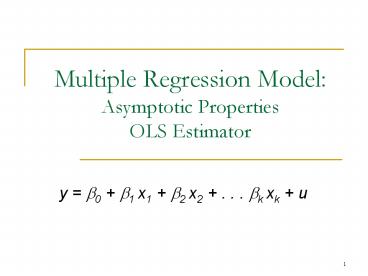Multiple Regression Model: Asymptotic Properties OLS Estimator - PowerPoint PPT Presentation
1 / 22
Title:
Multiple Regression Model: Asymptotic Properties OLS Estimator
Description:
Under the Gauss-Markov assumptions OLS is BLUE. ... However, under the Gauss-Markov assumptions, the OLS estimators will have the ... – PowerPoint PPT presentation
Number of Views:406
Avg rating:3.0/5.0
Title: Multiple Regression Model: Asymptotic Properties OLS Estimator
1
Multiple Regression ModelAsymptotic
PropertiesOLS Estimator
- y b0 b1 x1 b2 x2 . . . bk xk u
2
Lecture 5 THE MULTIPLE REGRESSION MODEL
ASYMPTOTIC PROPERTIES OLS ESTIMATOR Professor
Victor Aguirregabiria
- OUTLINE
- Convergence in Probability the Law of Large
Numbers (LLN) - Consistency of OLS
- Convergence in Distribution the Central Limit
Theorem (CLT) - Asymptotic Normality of OLS
- Asymptotic Tests
- Asymptotic Efficiency of OLS
3
1. Convergence in Probability the Law of Large
Numbers
- Consider the sequence of random variables
- Z1, Z2, Zn,
- We say that this sequence converges in
probability to a constant c if for any small
constant e - the limit as n goes to infinity of Prob( Zn -
c gt e) is zero - That is, as n increases the probability
distribution of Zn becomes closer and closer to
the constant c. - In the limit, the random variable Zn is equal to
the constant c with probability 1.
4
Law of Large Numbers (LLN)
- Let y1, y2, yn be a random sample of a random
variable Y, that has a finite variance. - Define the sample mean
- The LLN says that the sample mean converges in
probability to the population mean of Y.
5
Consistency
- Under the Gauss-Markov assumptions OLS is BLUE.
- However, when we relax some of the assumptions
(constant variance) it wont be always possible
to find unbiased estimators. - In those cases, we may still find estimators
that are consistent, meaning as n ? 8, the
distribution of the estimator collapses to the
parameter value
6
Sampling Distributions as n ?
n3
n1 lt n2 lt n3
n2
n1
b1
7
2. Consistency of OLS
- Under the Gauss-Markov assumptions, the OLS
estimator is consistent (and unbiased) - Consistency can be proved for the simple
regression case in a manner similar to the proof
of unbiasedness - Will need to take probability limit (plim) to
establish consistency
8
Proving Consistency
9
A Weaker Assumption
- For unbiasedness, we assumed a zero conditional
mean E(ux1, x2,,xk) 0 - For consistency, we can have the weaker
assumption of zero mean and zero correlation
E(u) 0 and Cov(xj,u) 0 - Without this assumption, OLS will be biased and
inconsistent!
10
Deriving the Inconsistency
- Just as we could derive the omitted variable
bias earlier, now we want to think about the
inconsistency, or asymptotic bias, in this case
11
Asymptotic Bias
- So, thinking about the direction of the
asymptotic bias is just like thinking about the
direction of bias for an omitted variable - Main difference is that asymptotic bias uses the
population variance and covariance, while bias
uses the sample counterparts - Remember, inconsistency is a large sample
problem it doesnt go away as add data
12
3. Convergence in Distribution Central Limit
Theorem
- Recall that under the CLM assumptions, the
sampling distributions are normal, so we could
derive t and F distributions for testing - This exact normality was due to assuming the
population error distribution was normal - This assumption of normal errors implied that the
distribution of y, given the xs, was normal as
well
13
3. Convergence in Distribution
- Easy to come up with examples for which this
exact normality assumption will fail. - Any clearly skewed variable, like wages,
arrests, savings, etc. cant be normal, since a
normal distribution is symmetric. - Normality assumption not needed to conclude OLS
is BLUE, only for inference.
14
Central Limit Theorem
- The central limit theorem states that the
standardized sample mean of any sample with mean
m and variance s2 is asymptotically N(0,1)
15
4. Asymptotic Normality of OLS
16
4. Asymptotic Normality of OLS
- Because the t distribution approaches the normal
distribution for large df, we can also say that
- Note that while we no longer need to assume
normality with a large sample, we do still need
homoskedasticity
17
Asymptotic Standard Errors
- If u is not normally distributed, we sometimes
will refer to the standard error as an asymptotic
standard error, since
- So, we can expect standard errors to shrink at a
rate proportional to the inverse of vn
18
5. Asymptotic Tests Lagrange Multiplier (LM)
Test
- Once we are using large samples and relying on
asymptotic normality for inference, we can use
more that t and F stats - The Lagrange multiplier or LM statistic is an
alternative for testing multiple exclusion
restrictions
19
LM Test
- Suppose we have a standard model,
- y b0 b1x1 b2x2 . . . bkxk u
- And our null hypothesis implies a restricted
model
20
LM Test
- First, we just run an OLS regression for the
restricted model. - Second, we take the residuals of the restricted
model and make the regression
21
LM Test
- Under the null hypothesis, we have that
- With a large sample, the result from an F test
and from an LM test should be similar
22
6. Asymptotic Efficiency of OLS
- Estimators besides OLS will be consistent
- However, under the Gauss-Markov assumptions, the
OLS estimators will have the smallest asymptotic
variances - We say that OLS is asymptotically efficient
- Important to remember our assumptions though, if
not homoskedastic, not true































